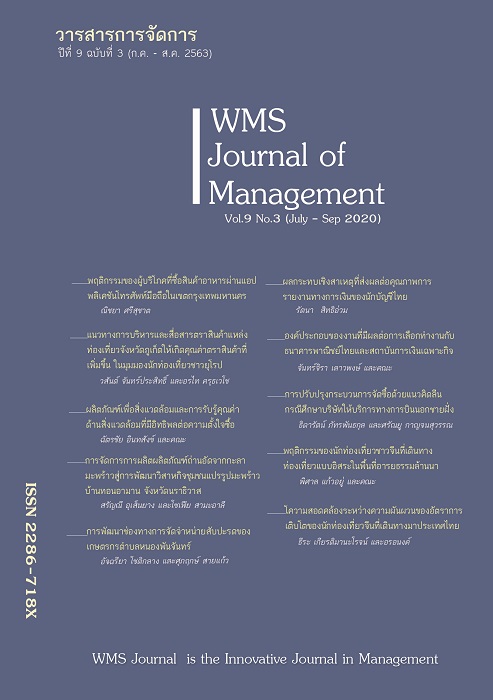Approaches to Brand Management and Brand Communication for Value Added Creation of Phuket as a Tourism Destination Brand in the Perspectives of European Tourists
Main Article Content
Abstract
In Thailand, Phuket province is only second after Bangkok as the most popular destinations for European tourists. Additionally, the number of European tourists in Phuket is the highest among foreign tourists. Drawing on literature review, tourists have positive responses to the tourism destination which has high brand equity. Consequently, the aims of this research were to 1) develop the measurement model of customer-based brand equity (CBBE) of Phuket destination from the perspectives of European tourists and 2) identify the approaches for managing and communicating Phuket as a tourist destination brand in order to create added values derived from the perspectives of European tourists from 15 countries. Mixed research methods, both qualitative and quantitative research were employed. Results showed that CBBE of Phuket destination from the perspectives of European tourists could be assessed through six components which include 40 indicators. Brand loyalty was particularly, the most important component, followed by perceived brand value, brand image, perceived brand quality, brand reliability and brand awareness respectively. The results also provide strategic approaches for destination marketing organizations and related stakeholders in Phuket brand management and marketing communication in order to create high CBBE of Phuket destination from the perspectives of European tourists.
Article Details
References
Akakun, T. (2003). Research methodology in Behavioral sciences and social sciences (3rd ed.). Ubon Ratchathani: Wittayakarnpim (in Thai).
Batey, M. (2008). Brand meaning. NY: Routledge.
Boo, S., Busser, J., & Baloglu, S. (2009). A model of customer-based brand equity and its application to multiple destinations. Tourism Management, 30, 219-231.
Ellwood, I. (2009). Brand Strategy. In R. Clifton (Ed.), Brand and branding (2 ed., pp. 73-95). NY: Bloomberg Press.
Gartner, W. C., & Ruzzier, K. M. (2011). Tourism destination brand equity dimensions: Renewal versus repeat market. Journal of Travel Research, 50(5), 471-481.
Goeldner, R. C., & Brent Ritchie, R. J. (2006). Tourism: Principles, practices, philosophies (10thed.). NJ: John Willey & Sons, Inc.
Hair, J. F., Anderson, R., Tatham, R., & Black, W. (1998). Multivariate data analysis (5thed.). Upper Saddle River, NJ: Prentice Hall.
Hoeffler, S., & Keller, K. L. (2003). The marketing advantage of strong brands. Journal of Brand Management, 10(6), 421–445.
Holloway, J. C. (1995). Marketing for tourism (3rded.). NY: Addison Wesley Longman Limited.
Hsu, H. C. C., Oh, H., & Assaf, G. (2012). A customer-based equity model for upscale hotels. Journal of Travel Research, 51(1), 81-93.
Im, H. H., Kim, S. S., Elliot, S., & Han, H. (2012). Conceptualizing destination brand equity dimensions from a customer – based brand equity perspective. Journal of Travel & Tourism Marketing, 29, 385 – 403.
Janprasit, W. & Anantachart, S. (2016). Development of customer-based brand equity model and measurement for Thailand tourism destination for marketing communications applications. Journal of Publications and Advertising, 9(1), 35-57.
Kapferer, J. N. (2012). The new strategic brand management (5thed.). UK: Les Editions d’ Organization.
Keller, K. L. (1993). Conceptualizing, measuring, and managing customer-based brand equity. Journal of Marketing, 57(1), 1-22.
Konecnik, M. (2006). Croatian-based brand equity for Slovenia as a tourism destination. Economic and Business Review, 8(1), 83-108.
Konecnik, M., & Gartner, C. W. (2007). Customer-based brand equity for a destination. Annals of Tourism Research, 34(2), 400-421.
McGrath, J. M. (2005). A pilot study testing aspects of the integrated marketing communications concept. Journal of Marketing Communications, 11(3), 191–214.
Middleton, T. C.V., & Clarke, J. (2001). Marketing in travel and tourism (3rded.). UK.: Reed Educational and Professional Publishing.
Ministry of tourism and sport. (2017a). Summary of revenue and expenditure from foreign tourists who visited Thailand in 2016. Retrieved from https://www.mots.go.th/more_news.php?cid
=411.
Ministry of tourism and sport. (2017b). Tourism statistics. Retrieved from https://www.mots.go.th
/more_news.php?cid=411.
Ministry of tourism and sport. (2015). Tourism strategies of Thailand, year 2015 – 2017. Retrieved from http://www.oic.go.th/FILEWEB/CABINFOCENTER3/DRAWER065/GENERAL/DATA0000
/00000359.PDF.
Morgan, N., Pritchard, A., & Piggott, R. (2003). Destination branding and the role of the stakeholders: The case of New Zealand. Journal of Vacation Marketing. 9(3), 285-299.
Nopkitkumjorn, P. (2017). Expedia releases research data related to European tourists’ behavior in 4 generations and suggests Thai hotels to adjust. Retrieved from http://www.forbesthailand
.com/news-detail.php?did=2092.
Percy, L. (2014). Strategic integrated marketing communications (2nded.). NY: Routledge.
Pike, S. (2007). Customer-based brand equity for destinations: Practical DMO performance measures. Journal of Travel & Tourism Marketing, 22(1), 51-61.
Pike, S. (2010). Destination branding case study: Tracking brand equity for an emerging destination between 2003 and 2007. Journal of Hospitality & Tourism Research, 34(1), 124-139.
Sangchoey, T. (2011). Difference of cultural dimensions and tourism behaviors. TAT Review, 2/2011, April – June, 43-63.
Sangpikun, A. (2009). An Analysis and Comparative Study of Travel Motivations and Travel Behaviors of International Tourists to Thailand. Bangkok: Faculty of Tourism and Hospitality, Dhurakij Pundit University.
Schultz, D. E. (1993). Integrated Marketing Communications: Maybe definition is in the point of view. Marketing News, January, (18), 17.
Shimp, A. T. (2010). Integrated marketing communications in advertising and promotion (2nded.). US: Cengage Learning.
Temporal, P. (2010). Advanced brand management: Managing brands in a changing world. Singapore: John Wiley & Sons (Asia) Pte. Ltd.
Tourism Authority of Thailand. (2016). European tourist behavior: Overview picture. Retrieved from https:// tatreviewmagazine.files.wordpress.com/2016/07/european-behavior.pdf.
Yoo, B., Donthu, N., & Lee, S. (2000). An examination of selected marketing
mix elements and equity. Journal of The Academy of Marketing Science, 28(2), 195-211.


